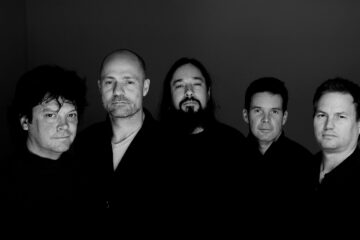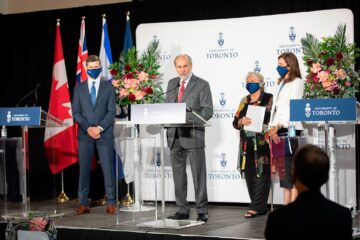Canada’s Walk Of Fame: Celebrating Awesome Canadians

The name says it all — it really is a walk of fame to honour Canadians and celebrate the next generation. It’s evolved, however, to include amazing people on a national level, telling their stories and bringing attention to communities across the country. The biggest difference? “The emphasis is on the walk, not the fame,” says Jeffrey Latimer, CEO of the organization.
If you’re strolling along the sidewalk in downtown Toronto’s Entertainment District, you’ll notice the maple leaf–like stars, filled with names of Canadians who inspire others. It’s an honour for inductees, of course, but it also inspires everyday people.
Canada’s Walk of Fame, a not-for-profit organization established in 1998 by founders Bill Ballard, Dusty Cohl and Peter Soumalias, with Dianne Schwalm and in partnership with Gary Slaight, has evolved from a small gathering to unveil a star in the sidewalk to include a gala, events across the country and year-long programs and celebrations to reach as many Canadians as possible. “Yes, we are here to celebrate and inspire,” says Jeffrey Latimer, CEO of the organization. “But, what’s different is that we’re doing it more nationally now, bringing more attention to communities where people grew up, telling more stories.”
To that end, the Walk of Fame recently introduced “Hometown Star Event, presented by Cinplex,” an additional celebration for those inductees whose hometowns are outside of Toronto. In the year following their induction, inductees revisit their hometowns, where they are warmly welcomed through public events and greeted by locals, friends and family who all shared in their rise to success journey. Inductees are also presented with a cheque to the charity of their choice, as well as a monumental plaque to be permanently displayed in a location of special significance to them. The conversations with inductees have changed to focus more on their walk, says Latimer, and include stories to show their struggle and determination. They are asked questions like, “What are you doing with your platform?” and “What are you doing with your fame?” Health-care workers or astronauts, for instance, may not be as well-known, but they make tremendous contributions, he adds.
Everything is different now; it’s not the ’90s anymore. People have platforms, followers and audiences on social media. “Are they saying, ‘Look at how famous I am’ or are they saying, ‘This is what’s important to me,’” asks Latimer. “We need to care about mental health, we need to care about what they’re doing to give to their country, to truly inspire, so that young people look at them as role models and say, ‘Wow, they fell down so many times and they got back up and now look at them.’”
This year’s inductees (there are 200 to date) are represented in Five Pillars of Achievement: Arts & Entertainment; Entrepreneurship and Philanthropy; Humanitarianism; Science, Technology and Innovation; and Sports & Athletics. That’s what makes Canada’s Walk of Fame so powerful — great achievement in many different arenas, adds Latimer. This year’s recipients include actor Keanu Reeves; retired Lt.-Gen. Rom o Dallaire; Salome Bey (Canada’s first lady of the blues); and Frederick Banting, Charles Best, John Macleod and James Collip, University of Toronto scientists who discovered insulin. Perhaps Reeves put it best when he talked about his profession, then talked about the scientists who discovered insulin, saving millions of lives, and what an honour it is to be inducted into the Walk of Fame the same year as them.
The most difficult part of the job for the organization is deciding on the inductees from all of the nominations. One thing the organization does look for now is the impact that the nominee is making, locally and nationally, and even internationally. “I think the biggest part of it now when we induct someone is, ‘What is it that their induction is going to do to make Canada a better place?’” says Latimer. So, it’s not always obvious, he adds, but some inductions are about the betterment of the country, because the organization shines a light on them in the same way it does for a movie star.
“It Is Important For Canada To Shine A Brighter Light On Extraordinary Canadian Achievers To Inspire More People, More Often”
This year, the organization introduced The National Hero Honour. It is presented to someone who has made outstanding contributions this year. “It can be anyone who represents what it is to truly be Canadian, [and] that’s what Laurent did,” says Latimer, who’s talking about Laurent Duvernay-Tardif, the first recipient of the award. A football player with the Kansas City Chiefs who was recently traded to the New York Jets, Duvernay-Tardif completed medical school in the off-seasons. At the start of the pandemic, he opted out of playing football to lend a hand working as an orderly at a long-term care facility in the Montreal area. That’s not all. A few years ago, he and his girlfriend, Florence Dubé-Moreau, cofounded the Laurent Duvernay-Tardif Foundation, dedicated to encouraging sports, arts and studies or kids. “It’s all about balance. Don’t give up on your passions,” he tells youth when he speaks at schools.
Similarly, the Community Hero program, presented by MLSE and Scotiabank, honours an exceptional Canadian under 30 who positively influences the lives of others and makes a profound impact on their communities. This year’s recipient is Rabiah Dhaliwal, an award-winning youth mental health activist, humanitarian and community leader. Her experiences as a youth of colour living with depression, anxiety and post-traumatic stress disorder have deeply affected the way she navigates life. As a survivor of suicide, Dhaliwal is passionate about mental health reform. She is the founder and director of Voices For Hope Foundation, a non-profit organization that challenges the stigma around mental health.
What’s coming down the pipeline? Latimer feels strongly that the organization will include more inductees from health care in the future. “I think our doctors are the biggest superstars in the world,” he says. “There are some doctors and researchers in this country — in Toronto, Calgary, Vancouver and Montreal — who are the best in the world.” And, he adds, they are as important as some of the great inductees in the performing arts categories.
There is no greater champion of our country than Latimer. He’s proud to represent such an organization as this one. And he’s proud of the team he works with. “I’m most proud that we continue to expand on a very powerful movement created by Canada’s Walk of Fame founders … that it is important for Canada to shine a brighter light on extraordinary Canadian achievers to inspire more people, more often,” he says. “I feel like we are really making Canada’s Walk of Fame mean more to more people — and that’s good for Canada.”
Latimer tells just about anyone who will listen that Canada is an incredible country filled with remarkable people. “This club of inductees is small, and yet the [number of ] extraordinary achievers in this country is massive,” he says. “What I’ve learned is that we should be inducting a hundred people a year. I’m very aware of how many amazing Canadians there are.”
www.canadaswalkoffame.com
@cwofame
Canadians can watch CELEBRATING GREATNESS: CANADA’S WALK OF FAME 2021, now streaming on Crave.
Interview by Estelle Zentil













































































